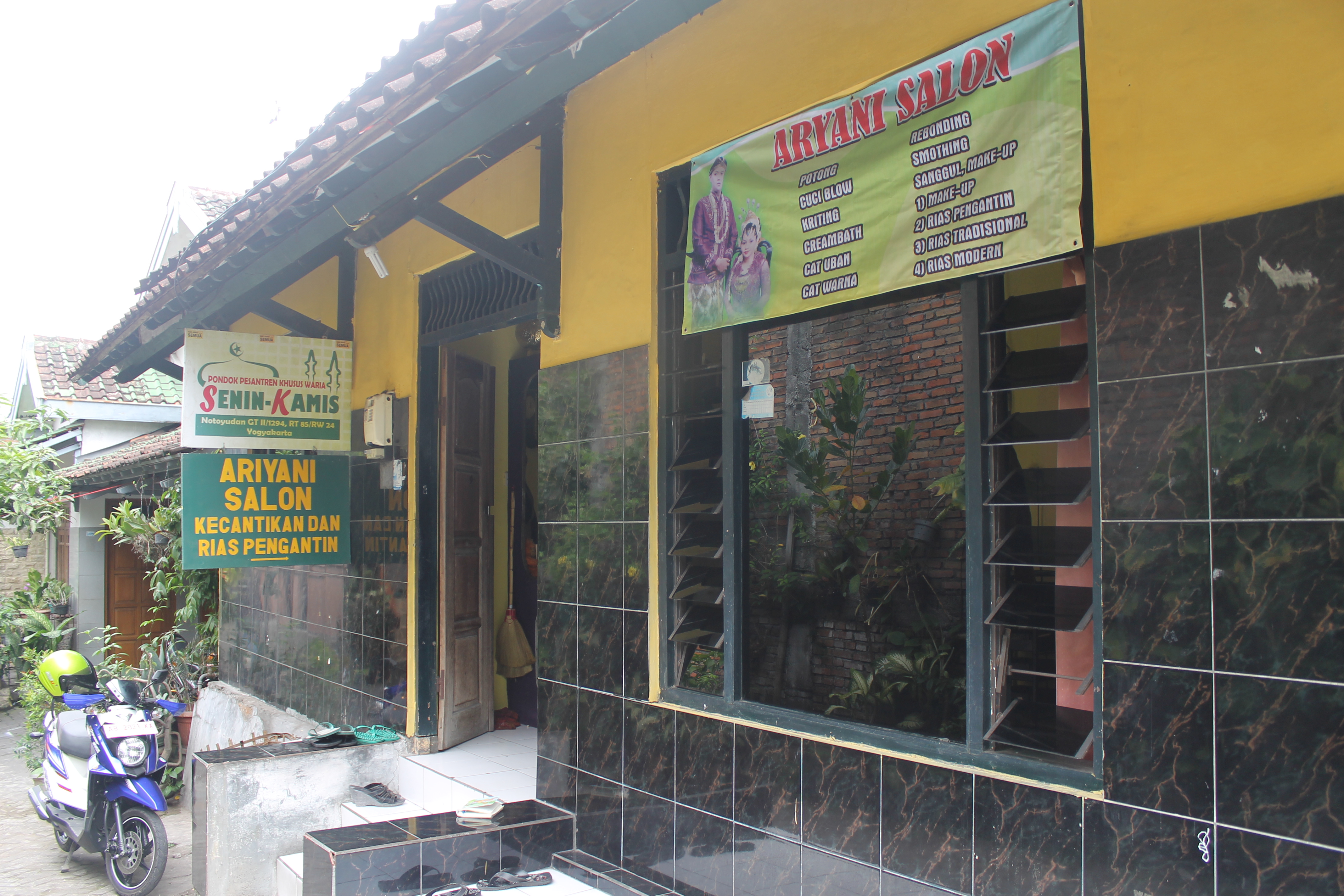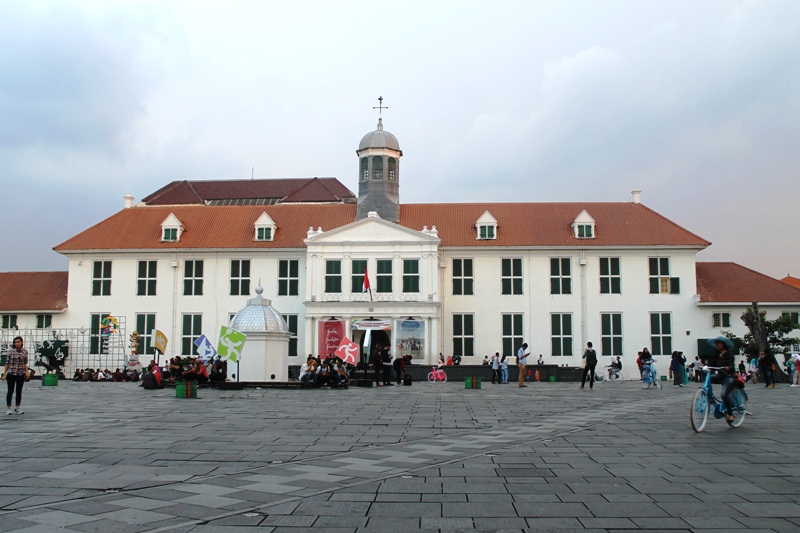INTRODUCTION
On December 2013, I visited a house in Jogjakarta that was partly used for transgender groups to pray and learn about Islamic teachings. On February 24 2016, the house was sealed as reported by BBC Indonesia.http://www.bbc.com/indonesia/berita_indonesia/2016/02/160225_indonesia_ponpes_waria_ditutup.shtml
In my visit, I met and spoke with Maryani, who led the Association of Waria (Transgender) of Jogjakarta. I just found out that Maryani died on March 2014. I wrote the story about my visit and tried to publish it, but none of the publishers was interested in it. I was releasing the story below based on my visit in 2013.
Pondok Pesantren Khusus Waria (Islamic boarding school for transgender) Senin-Kamis in Notoyudan neighborhood, Jogjakarta, was not easy to find for the first time. My driver needed to get off and on several times asking some residents in the area until we finally could spot it.
I was thinking I would find a kind of school building since pondok pesantren usually refers to a physical building. When I saw a house with two signs “Pondok Pesantren Khusus Waria Senin-Kamis” and “Ariyani Salon” in the front, I promptly realized that this unique pesantren is housed in a small residential home.

A person was sitting on the terrace by the door looking at a mobile phone. When I greeted “Salam Alaikum” and asked if it is the pesantren waria. The person who happened to be the pioneer of pesantren stood up and politely asked me to come in.
I entered the living room, which is about 12 square-meters. Against the wall there is a long simple bench for hairdressing, two plastic chairs and small plastic table are in the middle of the room. Some photos are hung on the wall. Next to the living room is another room where television, a tall bridal gowns hanger and a glass rack displaying some items for hair dressing are located. Some photos and certificates in frames decorate the wall. I was curious how these two small rooms could be shifted into a class for adults.
Maryani, the pioneer of pondok pesantren, took the hijab and covered the hair. Out of respect, I asked how I should address, “You could call me Ibu (Ma’am),” said the 55-year old transgender.

On Sunday and Wednesday evenings starting at 5 pm, the living room of Maryani’s decent rented house turns into a class. “We read shalawat (praises for Prophet Muhammad PBUH), perform Maghrib and Isya prayers, recite Alfatihah Sura and learn daily dua (prayer). The attendees are under the guidance of an ustadz (teacher),” said Maryani who converted to Islam 15 years ago. We have around 25 transgenders attending this pesantren.
“They wanted to go to a regular mosque but they are hesitant to do so, because most of them are rejected. Transgenders are human. They also have rights to learn about their religion and perform their religious duties,” she explained about why she wanted to have pesantren for trangenders.
In her pesantren, she provides mukenah (the prayer gown for women), but only three transgenders use them. The others just wear clothes as men when perform sholat (prayers).
KH Hamrolie Harun who passed away on Feb. 6 last year was the man behind this pondok pesantren. Harun was the founder of Pengajian Almujahadah Alfatah Jogjakarta where Maryani was one of his students. He founded this pondok pesantren in 2008, taught there and helped to guide Maryani to run it.

Maryani who stays single and adopts a child is enthusiastic when telling the activities of pesantren members in the community. “We pay a visit and pray in the graves of our transgender Muslim friends. We also take care the bodies of our friends who died because of sickness or train crash. You know most of them are abandoned by their families. In addition, we also join with the men congregates for tahlilan (recitation),” she added. After Mt. Merapi erupted in 2008, Maryani and her transgender friends helped to plant 500 trees on Mbah Marijan’s site of Mt. Merapi volcano.
“I provide everything for the class, from the place to refreshment.” Maryani runs the pesantren out of her own pocket. She earns some money from some clients of her bridal and hair salon. However, she complained that most of her transgender fellows that come to pesantren do not pay attention on her efforts to keep the pesantren running.

The big day for her pesantren is probably during Ramadhan (Muslim fasting month) where the pesantren holds tarawih prayer, tadarus (continual Quran recitation), and iftar and sahur meals together. After Eid, the pesantren usually holds halal bil halal (getting together), where Maryani also invites her transgender and non-transgender friends from other religions to come. “No religion is bad, it is only the matter of its followers,” she said wisely.
Maryani admitted that she didn’t have any resistance in running her pondok pesantren, from her neighborhood level to local police level. “It depends on how we socialize with our neighborhood. Moreover, Jogjakarta is indeed special. I am really grateful for having this,” she added.
With her independent effort, she managed to perform Umrah hajj pilgrimage (minor hajj). “It was really an invaluable experience for me. I could see that Allah Does not look at your background,” she said wholeheartedly.

Maryani doesn’t agree with negative impression about the transgenders. She does not care if people make fun of her transgender status either. “It is not a disease nor a choice of life. It is a destiny.” She continues to work to run her pondok pesantren despite of her financial burden. “I like to have a big transgender pengajian (Quran recitation class) of all over Indonesia.
The visitors of her pesantren are from different countries in Europe, Asia and America. Most of them want to learn more about this pesantren. In addition, students from universities in Jogjakarta and Java island also come to visit to make a research about it. “This is the only pesantren for transgender in the world,” she proudly said.
Ends
Interestingly, as a matter of fact, there were elements of transgenders and even homosexuality in some cultures in Indonesia. At that period of time, people (society) did not prosecute or criminalize it out of respect to the tradition and local cultural value.
These cultures do not exist anymore or they have evolved into a culture that has accommodated the values that are now commonly accepted. Here are some of them.
Bissu, South Sulawesi
Bissu is a clergy in the pre-Islamic ancient Bugis religion. Bugis is an ethnic group is South Sulawesi that had its own alphabet, dialect and government. The classical Bugis kingdoms included Bone (1634), Luwu, the first and the oldest in South Sulawesi, Soppeng (1609), and Wajo that ruled from 14th century to 17th century. Bugis people acknowledge five genders, men, women, calalai (effeminate men), calabai (masculine women), and bissu (androgyny).
The word bissu generates from the word bersih, an Indonesian word that means clean/pure. Bissu were considered clean because they do not menstruate and don’t have breasts. Bissu had a respectful position as they ran the traditional rituals and had roles to maintain the classical culture and values of Bugis culture. They were the ‘middle persons’ for the communication with the spiritual world. In La Galigo, an epic of Bugis, bissu is considered semi-sacred that descended from the gods. In the kingdom, they also served as spiritual adviser for the kings. They didn’t get married to maintain their sacred position.
As Indonesia has been changing in terms of socio-cultural and political situations, the existence and role of bissu have been much reduced, it may even be difficult to find a genuine bissu.
Warok and Gemblak, East Java
Ponorogo, a small city in East Java Province of Indonesia, is considered to be the origin of reog. Reog is a performance where the main performer wears a giant mask of picturing the tiger, singa barong, the king of the forest that symbolizes Kertabhumi, the last King of Majapahit in the 15th century. On top of the mask is a row of big peacock feathers symbolizing the strong influence of the Chinese within the kingdom.
There are a number of versions of the origin of reog. One of them is about the rebellion in Majapahit Kingdom in 15th century. An aide in the kingdom, Ki Ageng Kutu, was restless because the wife of King Kertabhumi, who came from China, had strong influence to the king. In addition to that, the King did nothing to overcome the corrupt government at the kingdom. Ki Ageng Kutu envisioned the kingdom would collapse.
Ki Ageng Kutu left the palace and opened a training center for the youths to learn martial arts, the power of invulnerability and mysticism. The youths were expected to be a new better generation if Kingdom Majapahit reemerged. He created a performance that was called Reog as a mechanism to gain influence from the locals to topple the king.
In reog performance there were a performer that wore the giant mask, a company of waroks and a group of jatilan. Jatilan is a group of young boys that rode horse figures made of weaving bamboo. It symbolized the cavalry of Majapahit Kingdom. Jatilan was performed by gemblak.
King Kertabhumi was not happy with reog. He attacked the training center of Ki Ageng Kutu and terminated the rebellion that warok would commit. The performance kept going secretly among the community.
Warok relied on the truth in the battle between the truth and evil. As individual, warok should give spiritual guidelines as as well as protection to the people unconditionally. It is believed that warok had certain mystical power. It took a lot of efforts to become a warok, there were a number of action items as prerequisites to become a warok, such as controlling the lust, hunger and thirsty as well as not touching the women. Their mystical power would deprive if they touched women.
Therefore, waroks had gemblak. Gemblak was 12-15 years old young boy. These boys were usually good looking and well cared. A warok could have more than one gemblak that lived with him. The gemblak was under his protection and care. Having gemblak for warok was a tradition that strongly rooted in the community of reog. The community could accept it.
A warok was a real man, he had wives and children. The gemblak was released from the life of a warok when the warok discontinued to be warok or he wanted to have another younger gemblak. It was also normal for the warok to find the wife for his gemblak. A warok would return to his family when he was no longer a warok.
The tradition of reog Ponorogo now has been reduced to be a performance only because of the socio-cultural and political change in Indonesia. There are no longer warok and the dancers in jatilan are now replaced by girls.
Ludruk, East Java
Ludruk is a traditional theater that is originated from East Java. The story in ludruk is usually about daily life or social critic that is conveyed in a humorous way. The dialogue in ludruk uses egalitarian language that can be understood by many.
There are a number of versions how ludruk was started. It was probably started in the 18th century in East Java.
The performers of ludruk are all men, either for women roles or men roles.
Gandrung, Banyuwangi, East Java
Gandung is traditional dance from Banyuwangi in East Java. The dance was originally performed by young men that were dressed up as women. These young men were usually at the age between 7 to 16 years old. They moved from one village to another with the musicians to perform for the dance. However, in the 19th century, gandung lanang (gandrung performed by men) gradually disappeared. Gandrung lanang totally disappeared from Banyuwangi in 1914 when its last dancer died.
Now gandrung is performed by girls only and becomes Banyuwangi traditional dance.

